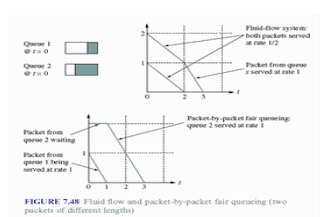§ Fair queueing provides equal
access to transmission bandwidth.
§ Each user flow has its own
logical queue which prevents hogging and allows
differential loss probabilities
§ C bits/sec is allocated equally
among non-empty queues.
§ The transmission rate = C / n
bits/second, where n is the total number of flows in
the system and C is the
transmission bandwidth.
§ Fairness: It protects behaving
sources from misbehaving sources.
§ Aggregation:
o Per-flow buffers protect flows
from misbehaving flows
o Full aggregation provides no
protection
o Aggregation into classes
provided intermediate protection
§ Drop priorities:
o Drop packets from buffer
according to priorities
o Maximizes network utilization
& application QoS
o Examples: layered video, policing at network edge.
The above figure
7.46 illustrates the differences between ideal or fluid flow
and
packet-by-packet fair queueing for packets of equal length.
• Idealized system assumes fluid
flow from queues, where the transmission bandwidth is divided equally among all
non-empty buffers.
• The figure assumes buffer1 and
buffer 2 has single L-bit packet to transmit at
t=0 and no subsequent packet
arrive.
• Assuming capacity of C=L
bits/second=1 packet/second.
• Fluid-flow system transmits
each packet at a rate of ½ and completes the transmission of both packets exactly
at time=2 seconds.
• Packet-by-packet fair queueing
system transmits the packet from buffer 1 first
and then transmits from buffer 2,
so the packet completion times are 1 and 2 seconds.
The above figure illustrates the differences between ideal or fluid flow
and packet-by-packet fair queueing for
packets of variable length.







0 comments